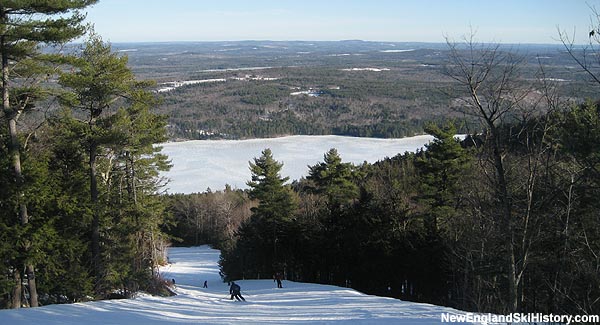
|
|
Located on the northern end of Pleasant Mountain, Shawnee Peak is the oldest major ski area in Maine.
Early Skiing on Pleasant Mountain
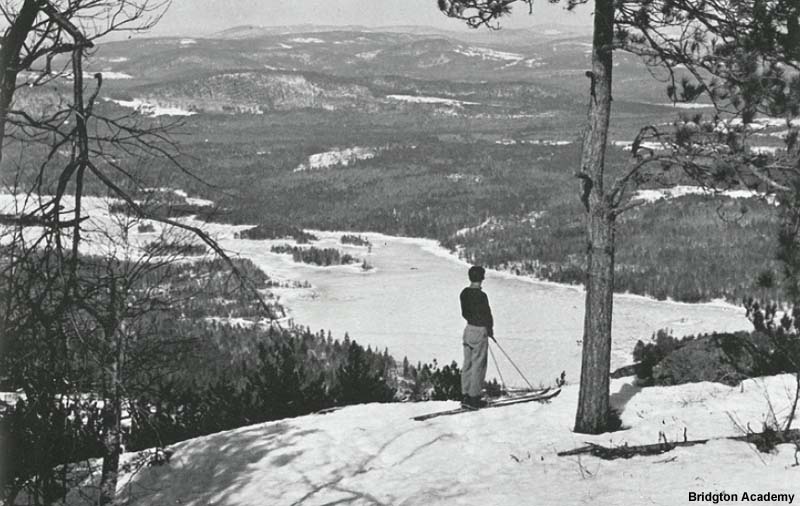
Early skiing on Pleasant Mountain |
Shawnee Peak's skiing history dates back to 1935, when multiple groups started developing a winter recreation area on the northern slopes of Pleasant Mountain. The Bridgton Lions Club, Bridgton Chamber of Commerce, Bridgton Academy, Portland Ski Club, and Bridgton Civilian Conservation Corps joined together to construct the Wayshego Trail (reportedly first referred to as the Cohechee Trail). Laid out by Max Wheildon, Bud Dow, and Clarence Kneeland, the 1.5 mile trail was only the start of what was to come.
In 1937, Bridgton selectmen obtained a Works Progress Administration grant for further development of the ski area. A team of 40 started work, eventually growing to 125. A 1,100 foot rope tow reportedly opened on January 23, 1938, serving lower mountain slopes. The Wayshego Trail was also widened and smoothed for that winter, while other attractions included a ski jump and cross country skiing. By the time the 1938-39 season rolled around, some $20,000 had been invested in the project.
The Wayshego Trail was expanded to 50 to 100 feet wide with corduroy-logged banked curves for the 1939-40 season. The Pleasant Mountain Ski Club hosted prominent races on the trail that winter.
Around this time, the Pleasant Mountain Ski Club took charge of improvements. For the 1940-41 season a 300 foot rope tow was added for beginners, while a tow was reportedly installed near Highland Lake for a toboggan chute. Meanwhile, in the fall of 1940, the voters of the town of Bridgton appropriated funds to acquire the land on which the ski area was located. The Bridgton Chamber of Commerce operated the ski area that winter. In the spring of 1941, the town acquired the land and subsequently leased it to the chamber, which was which was developing plans to install an aerial tramway on the mountain.
For the 1941-42 season, the parking lot was tripled in size and a new slope was reportedly constructed. Operations continued through the winter, but momentum was stalled with the onset of American involvement in World War II.
Following World War II, Russell Haggett became general manager of the ski area. Meanwhile, the Wayshego Trail was renamed Jack Spratt in honor of Pleasant Mountain's second manager. Starting in the spring of 1946, the Pleasant Mountain Ski Development Corporation began to acquire property. During the 1947-48 season, the partners of Pleasant Mountain Ski Development Corporation were Haggett, Pleasant Mountain House owner Ray Riley, and ski instructor and ski shop manager Luke Evans.
The main slope was extended further up the Jack Spratt trail for the 1948-49 season, while a new intermediate trail was cut and a new rope tow constructed. In the midst of a snow drought, prominent races were postponed or cancelled that winter, including the January Pleasant Mountain Ski Club Downhill.
Many Firsts at Pleasant Mountain

The first T-Bar circa 1955 |
Pleasant Mountain announced a $40,000 expansion project in June of 1953, the centerpiece of which was a 2,000 foot long T-Bar. Maine's first T-Bar, the lift replaced two lower mountain rope tows.
Circa 1954, Ray Erickson (of Sam Aceto Construction Company) became a stockholder, joining Haggett, Riley, A.B. Cooley, and Eli Morin. In early 1955, construction began on a double chairlift. The lift had a $100,000 price tag, with E.G. Constam financing $45,700 of it. The first double chairlift in Maine, the lift climbed 1,200 vertical feet to the north peak of the mountain. Later known as "Old Blue," the lift was installed with summer and fall sightseeing in mind and likely opened before the snow flew in 1955.
After the two major lift projects, 1956-57 off-season work was limited to improving trails and expanding parking. Access was improved with a new paved access road, which also served as overflowing parking.
Tragedy struck on August 7, 1957, when a lift malfunction resulted in four injuries. The most seriously injured customer subsequently suffered a heart attack, spending more than a month at Maine Medical Center. A series of lawsuits followed over the next few years, as the failure was attributed to a fault bolt.
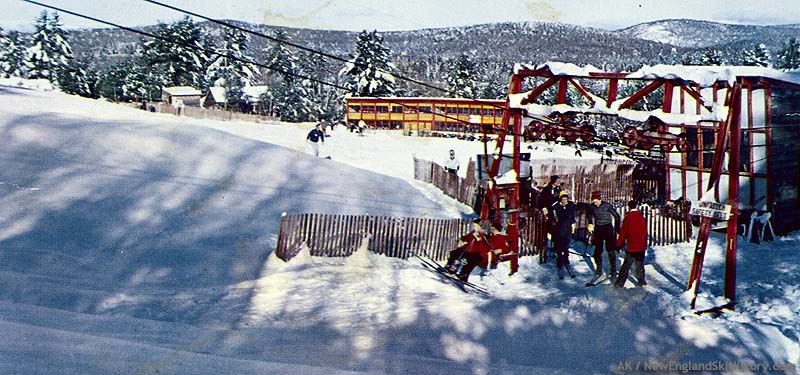
Old Blue |
The chairlift was repaired in time for the 1957-58 season, with a mid-station added to increase operating days, since the lift had been on hold due to limited upper mountain snow at times during prior years. In addition, the Jack Spratt trail was widened.
The 1957-58 season got off to a slow start, losing the Christmas to New Year's holiday period. Snow soon arrived, resulting in strong business and a season that extended into April for a total of 118 days of operation.
Riley's Run was cut for the 1958-59 season, while the West Slope it led to was regraded to remove a side-slope. Meanwhile, Switzerland native Hans Jenni was hired as ski school director; his wife Barbara also played an active role in the ski school and office. Access to the mountain was improved with the reconstruction of US 302. With record crowds flocking to Pleasant Mountain that winter, Russ Haggett announced plans for another chairlift and expanded base facilities.
Cooley's Caper was cut as a dedicated race trail and base lodge was expanded for the 1959-60 season.
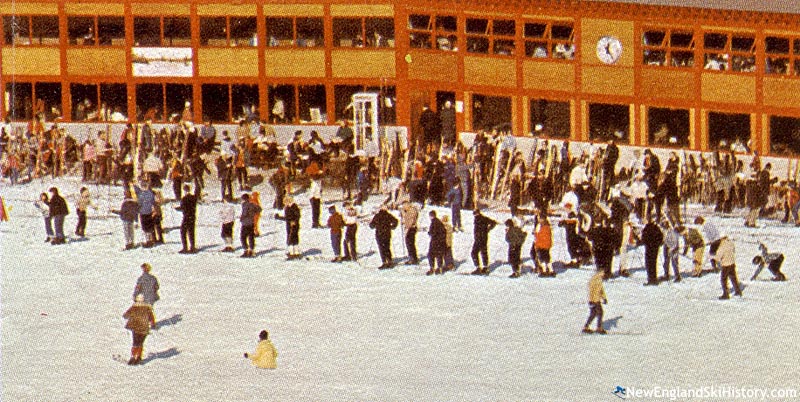
The base lodge circa the 1960s |
For the 1960-61 season, a short Doppelmayr T-Bar was installed, serving a newly cleared five acre novice slope in the vicinity of the present day Rabbit Run. The base lodge was once again expanded as well. Russ Haggett, described by the Boston Globe as "a giant of a man equally at home on a pair of skis, hunting in the woods or fishing a mountain stream," told the paper, "This has always been a family area catering to recreational skiers. Every improvement we make is done with these basic facts of operation in mind."
For the 1961-62 season, a "3000-foot slope cut 300 feet wide" was added. Named the East Slope, the 25-acre trail was augmented with a new T-Bar in 1962-63.
A new three-story wing was added to the base lodge for the 1963-64 season. In addition, $15,000 was spent on regrading and planting grass on one of its slopes. While northern ski areas struggled to open, Pleasant Mountain received enough natural snow to start operations in mid-December due to the track of the storms that winter.
Pleasant Mountain wasn't as lucky with the start of the 1964-65 season, as mild weather resulted in limited December skiing and the postponement of January races. When conditions improved by late February, a record number of skiers hit the slopes. As was the case for 1963-64, Pleasant advertised yet another lodge expansion that winter.
The lodge expansion was announced as completed for the 1965-66 season, with new cooking facilities added. Meanwhile, a new 1,000 foot trail (possibly an early version of Parmalee's Paradise) was cut from the top of the mountain, reportedly designed to retain snow better than the other upper mountain trails that tended to be battered by wind. In addition, room for another 100 cars was added to the parking lot. Washed out by an early January rain storm, 1965-66 was classified as an average season in an April business roundup.
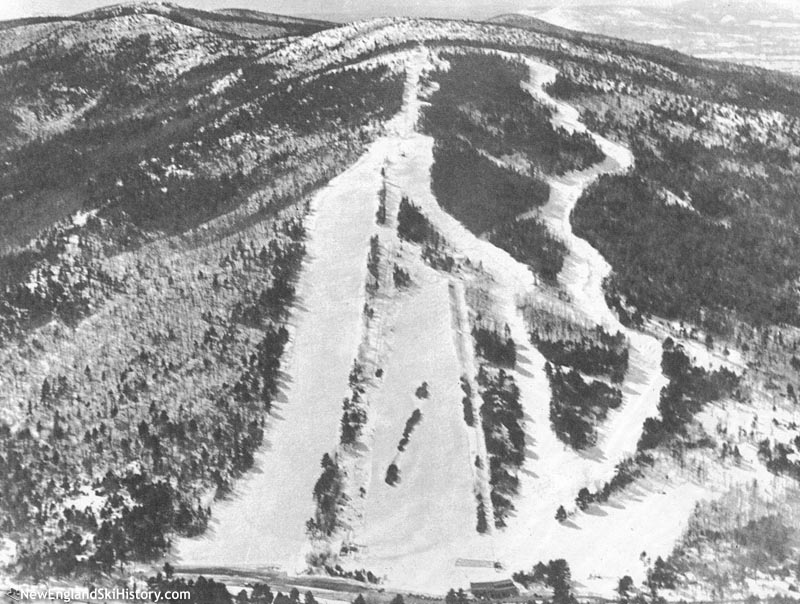
Pleasant Mountain in the 1960s |
After a quiet 1966 off-season, in 1967 Haggett announced additional land had been purchased and new trails and real estate opportunities would soon follow. Ralph Woodward took over as ski school director for the 1967-68 season. Governor Ken Curtis and his family hit the slopes at Pleasant Mountain in January.
A 400-unit housing development on Moose Lake was announced circa the 1968-69 season, including plans for a village center.
New Ownership
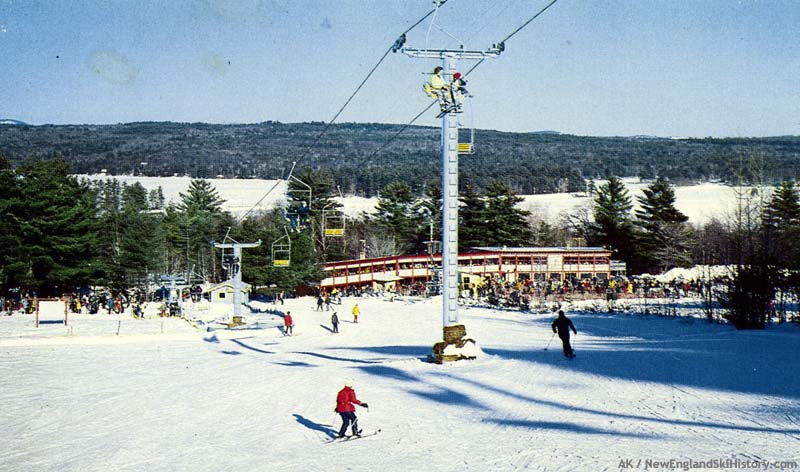
The Pine Double circa the 1970s |
On April 3, 1969, Sumner T. Bernstein, Virginia W. Libby, and Viola E. Smith formed the Pleasant Mountain Corporation. In early June, Russell Haggett announced the Pleasant Mountain Ski Development Corp. would be selling to the new company. The transaction was completed on June 30, with Ted Logan serving as president of the new company and Haggett remaining as general manager. In addition to moving forward with the real estate development, the new ownership announced the construction of a new lower mountain chairlift. A ten-inch snowstorm in October was seen as a preview of a strong season, though it did slow construction of the new lift. Ruedi Wyrsch took over as ski school director, as Ralph Woodward returned to Wildcat. Formerly the director of the Jiminy Peak ski school, Wyrsch was known for on-slope acrobatics, dressing up like a clown, and experimenting with new ski technology.
The 1969-70 season likely started the day after Christmas, but was quickly interrupted by torrential downpours. Crowds arrived after a subsequent snowstorm, leaving Fran Sayward of the Portland Press Herald to declare, "the holiday period shaped up as the craziest ever. Never has there been weather equal to it." The area also suffered through the failure of a motor on its new chairlift.
On January 11, 1970, the new Pine Double was formally dedicated as Governor Kenneth Curtis rang a cowbell provided by Stadeli. In addition, the new Happiness Is trail was named by the 13-year-old winner of the name the trail contest, Donna Witt. Waterville Morning Sentinel writer Betty Potter noted that the new lift was "smooth as silk," but noted the unloading area was dangerous because of the merging of three trails.
With the capital improvements and the hiring of Ruedi Wyrsch, Pleasant Mountain reported that its ski school business had tripled by late January. Weather was a struggle, as another rain event washed out the snow and shut down the area for half of February. Despite the blow, Russ Haggett noted, "we've had this situation before." Snow returned, allowing the area to operate into early April.
1970 off-season offerings included scenic chairlift rides, a gift shop, and dining. In mid-July, Pleasant Mountain experimented with turf skiing, providing free rentals and instruction. 90 skiers reportedly took part in the event.
The most significant improvement of the 1970 off season was the relocation of the novice T-Bar to a new area across the road due to the congestion created by the new chairlift. The Happiness Is trail was reportedly extended, while Upper Haggett's Hurdle, Jack Spratt, Cross Over, and Riley's Run were widened. Parking was expanded and a summit warming hut was constructed. The ownership also announced that land had been acquired for a future expansion. Meanwhile, the Knight's Hill real estate development was well underway, with 50 homes already constructed.
The 1970-71 season started on the weekend before Christmas. Enjoying natural snowfall, Pleasant Mountain enjoyed its best Christmas week to-date, reportedly hitting its 2,000 person capacity twice.
In January, Russ Haggett received a call from a print shop in Massachusetts, tipping him off on a counterfeit ticket scheme. Haggett notified the state police and soon two men with plans to sell 3,000 fake lift tickets were arrested. Following the discovery, security was hired to police tickets and season passes.
The 1970-71 season likely came to a close in early April. Around this time, Russ Haggett announced the departure of ski school director Ruedi Wyrsch.
Steve Haggett was named ski school director for the 1971-72 season. A cross country ski trail was cut, as well as a novice trail named McGregor's Thruway. The base lodge was reportedly doubled in size. The lifts started spinning during the second weekend of December. Though there were times with less than optimal conditions, Pleasant Mountain enjoyed a very snowy stretch from Washington's Birthday to mid-March, reportedly accumulating nearly four feet. The season likely ended after the second weekend of April.
The East Area Debuts
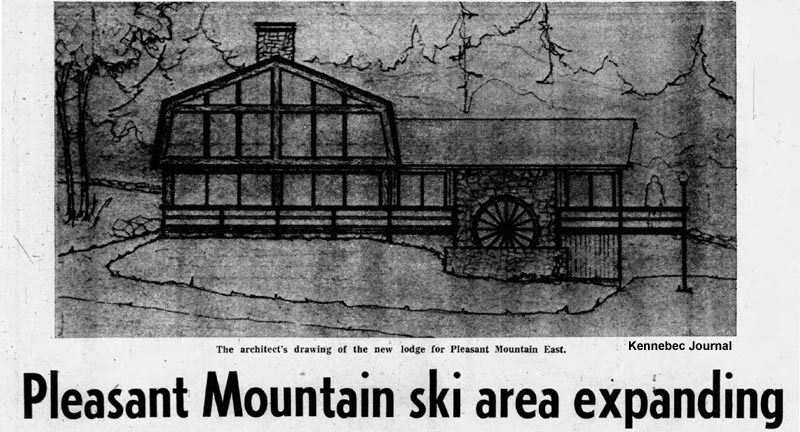
A 1972 rendering of the new Pleasant East base lodge |
A major expansion took place during the 1972 off-season, as the Pleasant Mountain East Area was developed. Serviced by a double chairlift, the new complex featured intermediate and expert trails designed by Russ Haggett, as well as a new base area. Towers were flown in via helicopter in November. Due to the number of trail junctions (12 "exits" and 4 major intersections), significant trail signage was needed, resulting in comparisons to a highway system.
The 1972-73 season started with fresh snow in mid-December, allowing two of the new East Side trails to debut. The new chairlift started spinning on Monday, January 15 after multiple late night work sessions. A dedication planned for the following weekend was postponed due to the January thaw. Washington's Birthday week was also a challenge, as "We combed the mountain looking for snow, when we found it, we scooped it up and placed it wherever it was needed," according to mountain manager Pete Solari. March was plagued with multiple heavy rains and mild temperatures, resulting in weekend-only operations after the first full week of the month, and lower-mountain-only soon thereafter. The season may have limped into calendar spring before coming to a close. At this point, management was reportedly considering the installation of snowmaking.
The poor weather of the spring of 1973 continued into the next season, as Pleasant Mountain missed the entire Christmas week and likely didn't open until early January, and even then on limited terrain. Coupling with the weather challenge was the energy crisis, leaving management to try to find ways to get people to the mountain.
After running Pleasant Mountain for three decades, General Manager Russ Haggett retired prior to the 1975-76 season. Squaw Mountain's Ron Kutkiewicz took over as General Manager for a short time before departing for Big Vanilla in New York.
Freestyle skiing became increasingly popular at Pleasant Mountain during the 1970s. In 1978-79, four of the ten United States qualifiers at the North American championships came from Pleasant Mountain. Meanwhile, to attempt to keep up with other ski areas, $100,000 was spent upgrading its trails, while the Old Blue chairlift was rebuilt.

Pleasant Mountain in the 1970s |
While Pleasant Mountain had been at the top of the state's ski industry for its first few decades, it found itself lagging behind the pack as the 1980s started. Lacking snowmaking, the ski area operated only 7 days in 1979-80 and a few dozen days in 1980-81.
On October 29, 1981, Pleasant Mountain Corporation leased the ski area to New PMC, Inc. for a one year term, with options to extend or purchase. A snowmaking system was quickly installed for the 1981-82 season. Later in 1982, an alpine slide opened for summer operations.
Okemo General Manager Ed Rock was hired to run Pleasant Mountain for the 1983-84 season. A Labor Day weekend 1983 fire at Pleasant Mountain's base lodge threatened to set the ski area back, however hard work resulted in the ski area opening that December. Top to bottom snowmaking debuted that winter.
Following the 1983-84 season, "Old Blue" was removed and replaced with a new Riblet triple chairlift.
$600,000 was invested in the snowmaking system for 1985-85 season. Amongst the improvements was a new pipeline from Moose Pond, providing significant water to the operation. Snowmaking was expanded to the East Side for 1987-88.
Pleasant Mountain Becomes Shawnee Peak
Following the 1987-88 season, the owners of Pleasant Mountain found themselves in financial trouble. That off season, they sold the ski area to Shawnee Mountain Corp. for $1.4 million. Pleasant Mountain was subsequently renamed to "Shawnee Peak," the name of the owners' Pennsylvania ski area.
For its debut season as Shawnee Peak, major changes were made to the ski area. A new Borvig double chairlift was installed near the original location of the novice T-Bar. Snowmaking was further expanded, while base area facilities were improved. Finally, night skiing was added on the lower mountain.
Night skiing was expanded to the summit for the 1989-90 season, giving Shawnee Peak the most lit terrain in New England. The 121 day season ended up setting records for length of season and number of skier visits.
Chet Homer Buys Shawnee Peak

The classic Mt. Washington view (2016) |
Circa 1992, the parent company decided to divest its skiing holdings, resulting in banks taking control of Shawnee Peak. After a couple of seasons on the bubble, Shawnee Peak was purchased by Tom's of Maine executive Chet Homer in September of 1994. Though Homer considered restoring the ski area's original name, he opted to keep the Shawnee Peak identity due to the brand that had been established.
After making under the hood improvements, Homer made a splash in 1997 when $1.2 million was invested in Shawnee Peak. In addition to a new beginner lift, two chairlifts were upgraded. The East Area's double chairlift was converted into a triple while the Pine Double was replaced with a new CTEC Quad chairlift.
For the 2010-11 season, the aging summit Riblet triple was replaced with a rebuilt CTEC triple, purchased from Loon, NH. The new lift was complemented with a conveyor loading system, allowing it to run faster than its predecessor. Four years later, the Rabbit Run chairlift was upgraded to a triple.
Ralph Lewis, Loon's Director of Ski Operations, became General Manager in September 2016 when Ed Rock retired. A new Magic Carpet lift was installed for the 2017-18 season.
Shawnee Peak Becomes Pleasant Mountain Again
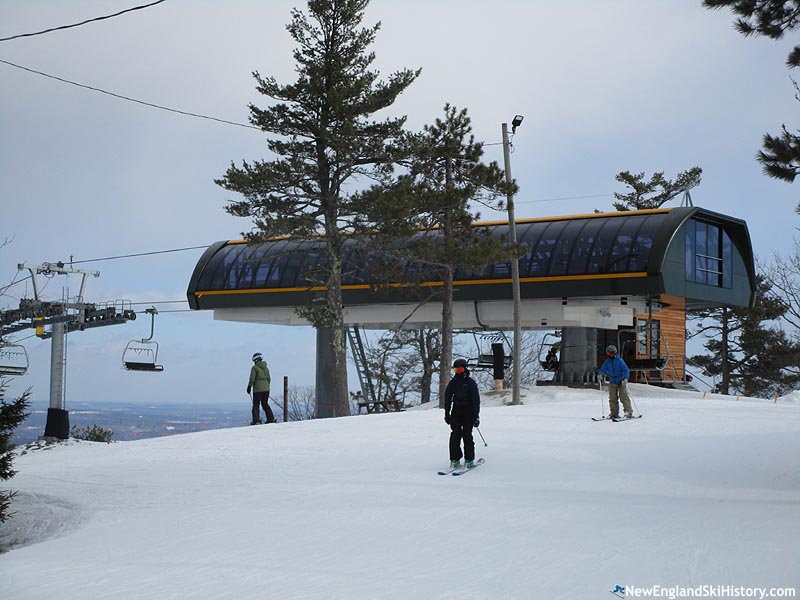
The Summit Express Quad (January 2025) |
On October 22, 2021, Chet Homer announced that he had sold Shawnee Peak to Boyne USA Resorts.
On September 14, 2022, the ski area reverted to its original Pleasant Mountain name. In 2024, Pleasant Mountain announced the installation of its first high speed detachable quad.
NewEnglandSkiConditions.com Reports
| Month |
Average Percent of Terrain Open |
| December | 10% (1 report) |  | | January | 54% (9 reports) |  | | February | 90% (2 reports) |  | | March | 90% (4 reports) |  | | April | 60% (1 report) |  |
|
| Recent Conditions Reports |
 | Jan. 26, 2025 by rocket21
Frozen Granular, Loose Granular |
 | Jan. 15, 2024 by newenglandskier13
Packed Powder, Variable Conditions |
 | Apr. 3, 2021 by newenglandskier13
Spring Snow, Frozen Granular |
 | Mar. 28, 2021 by nhalex
Corn, Bare Spots |
 | Mar. 27, 2021 by nhalex
Corn, Frozen Granular |
|
|
| Pleasant Mountain on NewEnglandSkiConditions.com |
NewEnglandSkiIndustry.com News
Expansion History
Image Gallery
Lifts
Click on lift name for information and photos
Maps
Year by Year History
Adult Weekend Full Day Lift Ticket; Adult Full Price Unlimited Season Pass. Window price, including RFID fee and taxes when known.
| 2020s |
Ticket Price |
Season Pass Price |
Pass Payback |
Opening Day |
Closing Day |
Skier Visits |
| 2025-26 | $97.00 |  | $989.00 |  | 10.2 days | December 6 | | |  | | | 2024-25 | $95.00 |  | $979.00 |  | 10.3 days | December 6 | April 6 | |  | | | 2023-24 | $94.00 |  | $949.00 |  | 10.1 days | December 8 | April 8 | |  | | | 2022-23 | $89.00 |  | $924.00 |  | 10.4 days | December 16 | April 2 | |  | | | 2021-22 | $88.00 |  | $825.00 |  | 9.4 days | December 17 | April 3 | |  | | | 2020-21 | $86.00 |  | $795.00 |  | 9.2 days | December 18 | April 4 | |  | | | 2019-20 | $82.00 |  | $770.00 |  | 9.4 days | December 7 | March 15 | |  | |
| 2010s |
Ticket Price |
Season Pass Price |
Pass Payback |
Opening Day |
Closing Day |
Skier Visits |
| 2018-19 | $75.00 |  | $760.00 |  | 10.1 days | December 1 | April 1 | |  | | | 2017-18 | $72.00 |  | $725.00 |  | 10.1 days | December 16 | April 1 | |  | | | 2016-17 | $69.00 |  | $715.00 |  | 10.4 days | December 17 | April 2 | |  | | | 2015-16 | $65.00 |  | $710.00 |  | 10.9 days | December 12 | March 26 | |  | | | 2014-15 | $63.00 |  | $705.00 |  | 11.2 days | December 6 | April 5 | |  | | | 2013-14 | $62.00 |  | $699.00 |  | 11.3 days | December 7 | April 5 | |  | | | 2012-13 | $59.00 |  | $699.00 |  | 11.8 days | December 15 | March 31 | |  | | | 2011-12 | $59.00 |  | $709.00 |  | 12.0 days | December 17 | March 24 | |  | | | 2010-11 | $56.00 |  | $709.00 |  | 12.7 days | December 11 | | |  | | | 2009-10 | $53.00 |  | $709.00 |  | 13.4 days | | | |  | |
| 2000s |
Ticket Price |
Season Pass Price |
Pass Payback |
Opening Day |
Closing Day |
Skier Visits |
| 2008-09 | $52.00 |  | $779.00 |  | 15.0 days | December 13 | | |  | | | 2007-08 | $49.00 |  | $699.00 |  | 14.3 days | December 8 | April 6 | |  | | | 2006-07 | $47.00 |  | $699.00 |  | 14.9 days | December 16 | March 25 | |  | | | 2005-06 | $45.00 |  | $679.00 |  | 15.1 days | December 10 | March 26 | |  | | | 2004-05 | $44.00 |  | $699.00 |  | 15.9 days | | March 27 | |  | | | 2003-04 | $42.00 |  | $709.00 |  | 16.9 days | December 13 | March 28 | |  | | | 2002-03 | $42.00 |  | $699.00 |  | 16.6 days | December 7 | | |  | | | 2001-02 | $41.00 |  | $699.00 |  | 17.0 days | | | |  | | | 2000-01 | $39.00 |  | $675.00 |  | 17.3 days | | | |  | | | 1999-00 | $39.00 |  | $599.00 |  | 15.4 days | | March 26 | |  | |
| 1990s |
Ticket Price |
Season Pass Price |
Pass Payback |
Opening Day |
Closing Day |
Skier Visits |
| 1998-99 | |  | |  | | December 12 | | |  | | | 1997-98 | $38.00 |  | |  | | December 6 | | |  | | | 1996-97 | $35.00 |  | |  | | December 13 | April 6 | |  | | | 1994-95 | |  | |  | | December 15 | March 26 | |  | | | 1993-94 | |  | |  | | | April 3 | |  | | | 1992-93 | $31.00 |  | |  | | | | |  | | | 1991-92 | $31.00 |  | |  | | | | |  | | | 1990-91 | $30.00 |  | |  | | | March 31 | |  | | | 1989-90 | $29.00 |  | |  | | December 2 | | |  | |
| 1980s |
Ticket Price |
Season Pass Price |
Pass Payback |
Opening Day |
Closing Day |
Skier Visits |
| 1988-89 | $27.00 |  | $450.00 |  | 16.7 days | | | |  | | | 1987-88 | $23.00 |  | |  | | | | |  | | | 1985-86 | $19.00 |  | |  | | | | |  | | | 1983-84 | $17.00 |  | |  | | | | |  | | | 1982-83 | $15.00 |  | |  | | | | |  | | | 1980-81 | $12.00 |  | |  | | | | |  | | | 1979-80 | $10.00 |  | |  | | | | |  | |
| 1970s |
Ticket Price |
Season Pass Price |
Pass Payback |
Opening Day |
Closing Day |
Skier Visits |
| 1978-79 | $10.00 |  | |  | | | | |  | | | 1977-78 | $9.50 |  | |  | | | | |  | | | 1976-77 | $9.00 |  | |  | | | | |  | | | 1975-76 | $8.50 |  | |  | | | | |  | | | 1974-75 | $8.00 |  | |  | | | | |  | | | 1973-74 | $8.00 |  | |  | | January 5 | | |  | | | 1972-73 | $8.00 |  | |  | | December 16 | March 25 | |  | | | 1971-72 | $7.00 |  | |  | | December 11 | April 9 | |  | | | 1970-71 | $6.50 |  | |  | | December 19 | | |  | | | 1969-70 | $6.00 |  | |  | | December 26 | | |  | |
| 1960s |
Ticket Price |
Season Pass Price |
Pass Payback |
Opening Day |
Closing Day |
Skier Visits |
| 1968-69 | $6.00 |  | |  | | | | |  | | | 1967-68 | $5.00 |  | |  | | | | |  | | | 1965-66 | |  | |  | | December 18 | | |  | | | 1964-65 | $5.00 |  | |  | | December 29 | | |  | | | 1963-64 | $5.00 |  | |  | | December 14 | | |  | | | 1962-63 | $5.00 |  | |  | | | | |  | | | 1961-62 | $4.00 |  | |  | | | April 2 | |  | | | 1959-60 | $4.00 |  | |  | | | | |  | |
| 1950s |
Ticket Price |
Season Pass Price |
Pass Payback |
Opening Day |
Closing Day |
Skier Visits |
| 1958-59 | $4.00 |  | |  | | | April 5 | |  | | | 1957-58 | |  | |  | | | | 18,000 |  | | | 1954-55 | |  | |  | | December 23 | | |  | |
Visitor Memories
| "We had a camp on Moose Pond and skied Pleasant Mt during the '50's. As proof, we were featured in the picture of the 2 kids and parents loading the chair lift in this article.
I spend my mornings skiing, but spent my afternoons scouring the parking lot for dimes - which were immediately exchanged for the honey dipped donuts.
Most notably, that same picture was featured on the bottom of all the glass ash trays sold in the gift shop for which I still haven't see any royalties.
My brother and I will be doing an autograph session sometime before we die.
" | | Peter Dresser, Mar. 3, 2022 | | "My father Russ Haggett loved this mountain. Spent much of his life there .we lived in the first hut in the early years. He started the first ski program for local kids as I remember it was free. Of course that was in the 50s. Times have sure changed as far as being affordable for some." | | Janet Underwood, Feb. 11, 2019 | | "Myself and my twin brother Tom learned to ski at Pleasant Mt. starting in 1964 at the tender age of 5, I remember the best honey dipped donuts at the base, and a ski patrol gentlemen named Mr. Fanklin who would allow us , after we became better skier to accompany him on the last sweep of the day! " | | Alie Shaughnessy, Feb. 14, 2017 | | "I skied here while I was attending Bridgton Academy (59-60)It was a fun place but small.Looks much better now." | | bill jenks, Feb. 7, 2017 | | "Our family history says my grandfather, Hugh Douglas MacCormack, an employee of Mr. Malcolm cleared the first trail on Shawnee Peak with a horse and plow. It was some sort of business deal between Mr. Malcolm and the owner of Land. Mr. Malcolm used the wood from clearing the trail to build 'Trails End' the first compound on Long Lake in Bridgton. My grandfather built this compound for Mr. Malcolm. My grandfather was born in 1890 in Canada. My dad his eldest was born in 1923 about the time this would have happened. The road leading to 'Trails End' in Bridgton, is named after Mr.Malcolm. " | | susan maccormack - mclaughin, May. 18, 2014 |
|
External Links
Shawnee Peak Ski Area - official site
Pleasant Mountain - FranklinSites.com Hiking Guide
|
Last updated: April 29, 2025
|



